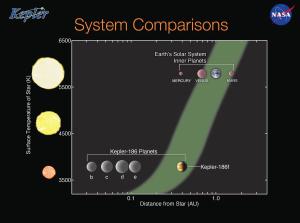Blog
Twins
18 April 2014
 NASA/Ames/SETI Institute/JPL-Caltech
NASA/Ames/SETI Institute/JPL-CaltechNASA and JPL have announced the discovery of an Earth-sized planet orbiting in the habitable zone of its star.1 This has led to some popular press announcements that Earth’s twin has been discovered, but these planets are twins more in line with Danny DeVito and Arnold Schwarzenegger than identical twins. It should also be emphasized that being in the “Goldilocks Zone” of a star does not mean the planet harbors life, or even liquid water. So what do we know about this planet so far?
 NASA/JPL
NASA/JPLThe planet is named Kepler-186f, and is the 5th planet from its star, Kepler 186. The star itself is a red dwarf about half the mass of the Sun. The Kepler study shows now evidence of large solar (stellar) flares over the 4-year observation period, but we do know the star is active, and even that it has starspots. This is an important factor when considering habitability, because red dwarf stars tend to have strong flares and stellar wind, which would act to strip closer planets of their atmosphere. Red dwarf stars also tend to be much hotter in their youth, only later cooling down to their reddish orange hue. So planets of such a star may be baked dry as well.
But it’s not all bad news. Since the star is smaller and thus cooler than the Sun, it’s habitable zone is closer to the star. In this case, Kepler-186f has an orbit roughly the size of Mercury’s orbit in our own solar system. At that distance the planet might not be tidally locked, so it could have a daily cycle similar to Earth’s. It is only about 10% larger than Earth, and while we can’t determine its mass directly, if it is about the same composition as Earth it would have a mass about 1.4 times that of Earth. That would give it a surface gravity only 15% stronger than Earth’s, so it isn’t likely to have a thick hydrogen-helium atmosphere.
If Kepler-186f has a strong magnetic field, then it is possible that it has a more Earth-like atmosphere, and would be capable of having liquid water on its surface. Given its size, it could also be geologically active. It is possible that the planet is the most Earth-like exoplanet discovered so far. However the most likely scenario is that it is dry and cold. More Mars-like than Earth-like.
Of course none of this should minimize the importance of this discovery. It shows that Earth-sized planets do exist within the habitable zones of their stars. We figured they must exist, but now we know. It is a first step toward discovering a truly Earth-like planet around another star.
Quintana, Elisa V., et al. “An Earth-sized planet in the habitable zone of a cool star.” Science 344.6181 (2014): 277-280. ↩︎